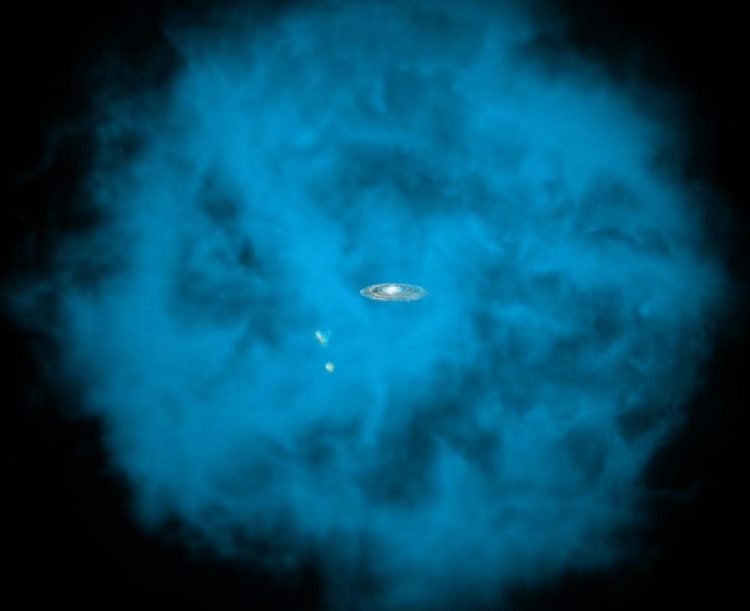Astronomers discover dizzying spin of the Milky Way galaxy's 'halo'

Our Milky Way galaxy and its small companions are surrounded by a giant halo of million-degree gas (seen in blue in this artists' rendition) that is only visible to X-ray telescopes in space. University of Michigan astronomers discovered that this massive hot halo spins in the same direction as the Milky Way disk and at a comparable speed. Credit: NASA/CXC/M.Weiss/Ohio State/A Gupta et al
“This flies in the face of expectations,” says Edmund Hodges-Kluck, assistant research scientist. “People just assumed that the disk of the Milky Way spins while this enormous reservoir of hot gas is stationary – but that is wrong. This hot gas reservoir is rotating as well, just not quite as fast as the disk.”
The new NASA-funded research using the archival data obtained by XMM-Newton, a European Space Agency telescope, was recently published in the Astrophysical Journal. The study focuses on our galaxy's hot gaseous halo, which is several times larger than the Milky Way disk and composed of ionized plasma.
Because motion produces a shift in the wavelength of light, the U-M researchers measured such shifts around the sky using lines of very hot oxygen. What they found was groundbreaking: The line shifts measured by the researchers show that the galaxy's halo spins in the same direction as the disk of the Milky Way and at a similar speed–about 400,000 mph for the halo versus 540,000 mph for the disk.
“The rotation of the hot halo is an incredible clue to how the Milky Way formed,” said Hodges Kluck. “It tells us that this hot atmosphere is the original source of a lot of the matter in the disk.”
Scientists have long puzzled over why almost all galaxies, including the Milky Way, seem to lack most of the matter that they otherwise would expect to find. Astronomers believe that about 80% of the matter in the universe is the mysterious “dark matter” that, so far, can only be detected by its gravitational pull. But even most of the remaining 20% of “normal” matter is missing from galaxy disks. More recently, some of the “missing” matter has been discovered in the halo. The U-M researchers say that learning about the direction and speed of the spinning halo can help us learn both how the material got there in the first place, and the rate at which we expect the matter to settle into the galaxy.
“Now that we know about the rotation, theorists will begin to use this to learn how our Milky Way galaxy formed – and its eventual destiny,” says Joel Bregman, a U-M LSA professor of astronomy.
“We can use this discovery to learn so much more – the rotation of this hot halo will be a big topic of future X-ray spectrographs,” Bregman says.
###
For more information, please visit: http://heasarc.
Media Contact
All latest news from the category: Physics and Astronomy
This area deals with the fundamental laws and building blocks of nature and how they interact, the properties and the behavior of matter, and research into space and time and their structures.
innovations-report provides in-depth reports and articles on subjects such as astrophysics, laser technologies, nuclear, quantum, particle and solid-state physics, nanotechnologies, planetary research and findings (Mars, Venus) and developments related to the Hubble Telescope.
Newest articles

Bringing bio-inspired robots to life
Nebraska researcher Eric Markvicka gets NSF CAREER Award to pursue manufacture of novel materials for soft robotics and stretchable electronics. Engineers are increasingly eager to develop robots that mimic the…

Bella moths use poison to attract mates
Scientists are closer to finding out how. Pyrrolizidine alkaloids are as bitter and toxic as they are hard to pronounce. They’re produced by several different types of plants and are…

AI tool creates ‘synthetic’ images of cells
…for enhanced microscopy analysis. Observing individual cells through microscopes can reveal a range of important cell biological phenomena that frequently play a role in human diseases, but the process of…





















